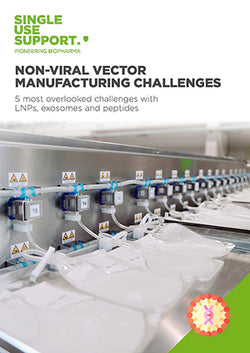Freezing LNPs & the impact on their long-term stability
In the world of pharmaceutical research and development, lipid nanoparticles (LNPs) have emerged as a promising platform for the delivery of various therapeutic agents. These LNPs offer exceptional benefits such as improved drug encapsulation, enhanced bioavailability, and targeted delivery. However, one critical aspect in LNP manufacturing that needs careful consideration is the long-term stability of LNPs during storage and transportation.
In this article, we discuss challenges associated with LNP stability and explore techniques for freezing LNPs to ensure their prolonged stability.
Understanding LNPs
LNPs are nano-sized vesicles composed of lipids that are utilized as carriers for delivering drugs, nucleic acids, and vaccines to target sites within the body. Due to their versatile nature, LNPs have gained significant attention in the pharmaceutical industry as potential delivery systems. However, ensuring the long-term stability of LNPs is crucial to preserve their integrity and efficacy over extended periods, and must also consider the individual temperature requirements of the biomaterials they contain.

What are LNPs?
LNPs, also known as lipid-based nanoparticles, are colloidal particles with a lipid bilayer structure that encapsulates therapeutic payloads. These nanoparticles can be tailored to accommodate various types of drugs, including small molecules and genetic materials. The lipid composition of LNPs plays a vital role in determining their stability and drug delivery capabilities.
Importance of LNPs in drug delivery
LNPs have revolutionized the field of drug delivery by addressing the limitations of conventional approaches. They offer improved stability, protection of payloads, and the ability to overcome biological barriers, allowing efficient and targeted delivery of therapeutics.
LNPs have shown promise in applications such as cancer treatment, gene therapy, and vaccine development. While LNP-based mRNA vaccines against SARS-CoV-2 have already been approved by the FDA, intense research is going on in the attempt to explore the entire potential of lipid nanoparticles.
Read more about LNPs for mRNA delivery
Importance of long-term stability
Long-term stability is crucial for the storage and transportation of LNPs. It allows for extended shelf life of LNP products, enabling pharmaceutical companies to manage inventory efficiently. Stable LNPs also facilitate the distribution of drugs to various locations, including remote areas.
The stability of LNPs directly affects the performance of encapsulated drugs. Unstable LNPs may lead to premature drug release, reduced drug loading, or loss of therapeutic activity. By achieving long-term stability, the drug efficacy can be preserved, ensuring optimal therapeutic outcomes.
Challenges in LNP stability
One of the primary challenges faced in LNP-based formulations is their inherent instability during storage. LNPs tend to undergo physical and chemical changes over time, leading to alterations in their size, encapsulation efficiency, and drug release properties. These stability issues can compromise the therapeutic efficacy and safety of the delivered drugs.
Several factors contribute to the stability of LNPs. Environmental conditions such as temperature, humidity, pH and light exposure can induce changes in the lipid bilayer structure, resulting in LNP destabilization. Additionally, interactions between LNPs and their surroundings, including proteins and ions, can further impact their stability.
[[download-1]]
What to consider when freezing
Freezing LNPs at low temperatures can minimize their degradation and maintain their integrity. Nevertheless, both physical instability (with the risk of mRNA leakage, aggregation and fusion) and chemical instability (risk of hydrolysis and oxidation) must be considered.
Cryoprotectants, such as sucrose, are commonly used in freezing LNPs. These compounds act as protectants by reducing the formation of ice crystals and stabilizing the lipid bilayer structure during the freezing process. By incorporating cryoprotectants, the LNPs can withstand freezing temperatures without significant damage.
While LNPs themselves do not necessarily have to be stored at ultra-cold temperatures, the same cannot be said for the biomaterials they contain. mRNA, for instance, is regularly stored at temperatures around -70 °C to maintain its integrity and translation efficiency. Therefore, measures have to be taken in order not only to prevent mRNA from deterioration, but also protect the lipid nanoparticles used as non-viral vectors.
Read more: Regulations for Cryoprotectants in ATMP Cryopreservation [[1]]

Plate freezing methods involve rapidly freezing LNPs down to temperatures far below 0 °C. This rapid cooling prevents the formation of large ice crystals, which can cause structural damage to the LNPs. Plate freezing preserves the size, morphology, and drug encapsulation properties of LNPs, contributing to their long-term stability.
The aforementioned cryoprotectants are also an indispensable component in the freezing process of LNPs: Research has shown that, for instance, the use of sucrose helps to maintain LNP stability at temperatures of -80 °C for up to a month. [[2]]
Optimizing freeze-thaw cycles
Freezing LNPs is often accompanied by subsequent thawing, as multiple freeze-thaw cycles may occur during storage and transportation. It is crucial to optimize these cycles to minimize potential damage to the LNPs.
A freeze-thaw cycle involves subjecting LNPs to freezing temperatures, followed by thawing at higher temperatures. This process can induce stress on the LNPs, potentially leading to structural changes. Understanding the effects of freeze-thaw cycles on LNPs is crucial for developing strategies to mitigate damage.
To minimize damage caused by freeze-thaw cycles, formulation optimization and the use of cryoprotectants are essential. Modifying the lipid composition, adjusting cryoprotectant concentrations, and employing controlled thawing protocols can help mitigate the detrimental effects of freeze-thaw cycles on LNPs, ensuring their long-term stability.
Analytical techniques for LNP stability assessment
Assessing the stability of LNPs is a critical step in their development and quality control. Various analytical techniques can provide valuable insights into the stability and performance of LNPs.
Monitoring the size distribution of LNPs over time can indicate changes in their stability. Dynamic light scattering (DLS) and nanoparticle tracking analysis (NTA) are commonly used techniques for assessing particle size and size distribution.
Furthermore, encapsulation efficiency is a measure of the amount of drug successfully loaded into LNPs. By periodically assessing encapsulation efficiency, any changes in LNP stability and drug loading can be detected, allowing for necessary adjustments in formulation or storage conditions.
Additionally, investigating the integrity of LNPs and their drug release properties is crucial for assessing their stability. Techniques such as transmission electron microscopy (TEM) and spectroscopic analysis can provide insights into LNP morphology, encapsulation integrity, and drug release kinetics.
Future directions and innovations
The field of LNP stability continues to advance, with ongoing research focused on improving freeze-thaw methods and developing innovative preservation techniques.

One important approach in freezing LNPs is based on plate freezing. This technique allows for fast and controlled freezing and thawing, making it possible to adjust to the specific temperature requirements of LNPs and the drug substances they encapsulate.
Single Use Support provides a product line up that covers the entire cold chain of LNPs (and beyond). With plate-based freezers, LNPs can be prepared for long-term storage within single-use bags in a controlled and efficient manner. And after being kept in ultra-cold storage freezers and/or transported in dedicated shipping containers, the thawing process of LNPs can be executed in an equally fast and precise way.
Furthermore, Single use Support offer solutions for filling and aliquoting LNPs, allowing a safe and automated fluid management process of both small and large volumes at a reduced risk of contamination or product loss.
Relying on single-use bioprocessing brings along several advantages to be profited from in LNP manufacturing. As already stated, the enhanced level of automation minimizes errors in highly complex pharmaceutical processes. Furthermore, the need for cleaning and sterilization at the manufacturer’s site can be reduced, which saves costs and resources. This is why single-use technologies are playing an increasingly vital role in several biopharmaceutical processes, including the manufacturing of LNPs and the groundbreaking drugs that are based on them.
References
- Lyophilized mRNA-lipid nanoparticle vaccines with long-term stability and high antigenicity against SARS-CoV-2, http://dx.doi.org/10.1038/s41421-022-00517-9, Published 2023-01-23
- The Effect of Cryoprotectants and Storage Conditions on the Transfection Efficiency, Stability, and Safety of Lipid‐Based Nanoparticles for mRNA and DNA Delivery, http://dx.doi.org/10.1002/adhm.202203022, Published 2023-03-12

Download guide
Guide: Challenges in Non Viral Vector Manufacturing
Guide about navigating 5 of the most overlooked challenges in non-viral vector manufacturing with regards to fluid management challenges, such as degradation and instability of LNP during freezing, scalability concerns in exosome manufacturing or protection against toxic solvents in peptide manufacturing.
